Any space may benefit from the striking red, burgundy, maroon, and deep pink hues offered by red-leaf plants. Brightly colored plants with green and red foliage provide color and warmth to interior design. In this article, let’s take a look at the different house plants with red leaves.
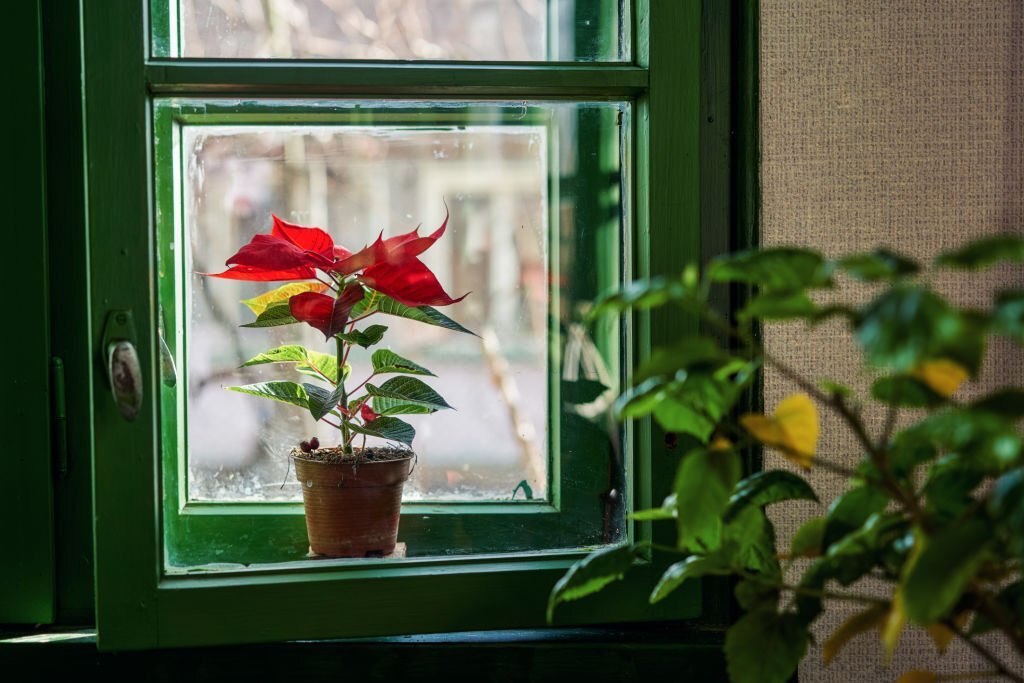
This bright red foliage may be found on several red-leaf houseplants. Some plant species naturally have crimson foliage. In contrast, other plants with red foliage are hybrids or cultivars having both green and crimson leaves. If you’re seeking for houseplants with red leaves, then you’re in for a treat.
A list of some of the most amazing red-leaf plants is provided in this article. You will also discover helpful gardening advice on where to cultivate these vibrant houseplants, along with descriptions of the foliage of the plants.
Must-Have House Plants with Red Leaves
1. Aglaonema or Chinese Evergreen
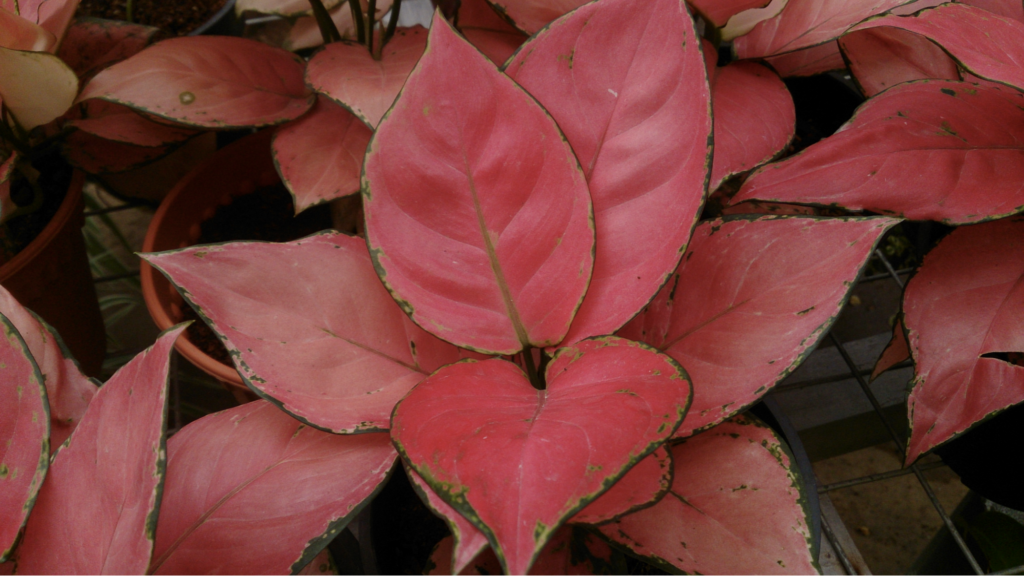
Some varieties of Chinese evergreen plants feature red and green-variegated leaves. Chinese evergreens feature large, elongated elliptic leaves that come in a variety of attractive tones and hues. A permeable, well-draining potting mix and indirect light are ideal for the Aglaonema genus of plants’ growth.
The following varieties of plants in the Aglaonema genus have red leaves:
- Red Aglaonema plant, known as Aglaonema “Siam Aurora,” has stunning red and green lanceolate leaves. The veining and borders of the green leaves are vibrant crimson.
- The large red-leaved houseplant Aglaonema’ Red Anjamani’ has brilliant red, oval leaves with sharp points. The leaf blades have delicate green veining and tiny green margins.
- Aglaonema’ Valentine’ is a striking, vibrant tropical houseplant due to its big crimson leaves with green edges and flecks.
RELATED: 36 Beautiful Aglaonema (Chinese Evergreen) Varieties You Must Have
2. Nerve Plant
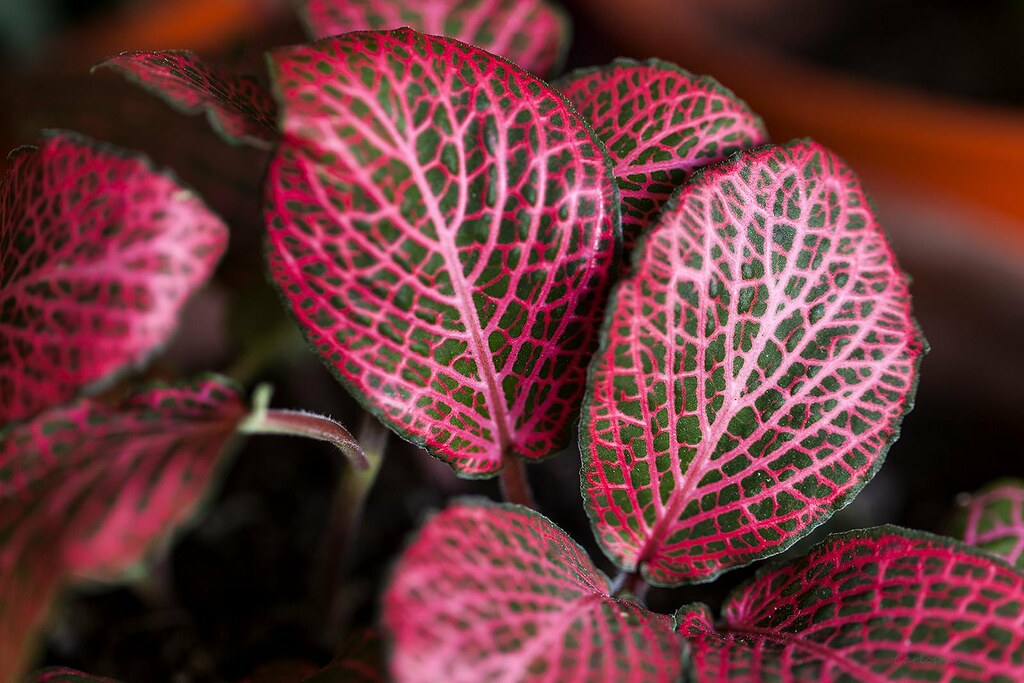
Small tropical houseplants, Nerve Plants, exhibit crimson mosaic patterns and dark green leaves on certain varieties.
The leaves of nerve plants have intricately patterned leaves that are round or egg-shaped. The veins on the leaves of nerve plants appear to be colored. Nerve plants can also have white, light green, or pink patterns in addition to red veining.
Here are several varieties of nerve plants with red and green leaves:
- The “Juanita” nerve plant has large leaves and brilliant red markings that resemble nerves.
- One of the compact nerve plant with striking pink-red veining is the “Red Anne” Nerve Plant.
- Nerve plant called “Black Star” has green leaves with striking purple-red markings.
- “Red Star” nerve plant has tiny, oval plant leaves are pinkish-crimson due to the plant’s vibrant red veins.
3. Coleus
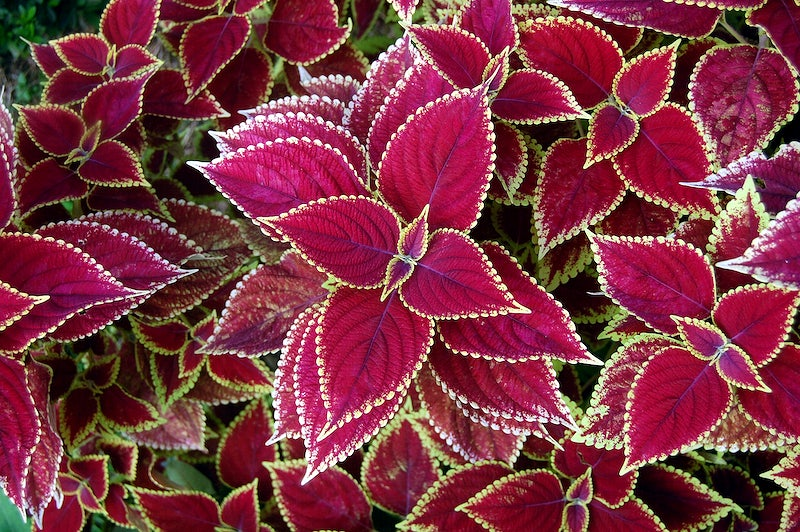
Numerous cultivars of the ornamental plant genus Coleus have vividly colored red leaves. The ovate leaves of these Coleus plants have serrated edges. Low-maintenance indoor plants called coleus cultivars feature crimson, burgundy, and green leaves, magenta pink, sunset orange, or even lime green with red edges.
Here are several red-leaved coleus indoor plants you can get:
- The leaves of the Coleus “Wizard Scarlet” are vivid crimson with vivid green borders. The ‘Wizard Scarlet’ Coleus thrives in sunny areas shielded from direct bright light and well-draining potting soil.
- Coleus ‘Redhead’, also known as Solenostemon Redhead, is a coleus plant with dark red ovate leaves that maintain their color whether grown in partial shade or direct sunlight. Numerous red leaves are seen on this bushy variety of Coleus that is grown indoors, along with some red and green foliage.
- The wide, light green leaves of the Coleus “Kong Crimson” have dark red and cherry red cores. To maintain the vibrant tropical foliage, it’s ideal for growing this houseplant in either partial or complete shade.
- The vivid lime-green leaves of the tropical delicate perennial plant Solenostemon ‘Pineapple’ (Coleus’ Pineapple’) have thin, crimson serrated edges. The tall, vivid ovate leaves are excellent for adding brightness to any space. For optimal results, grow this coleus plant in full sun or partial shade.
4. Poinsettia
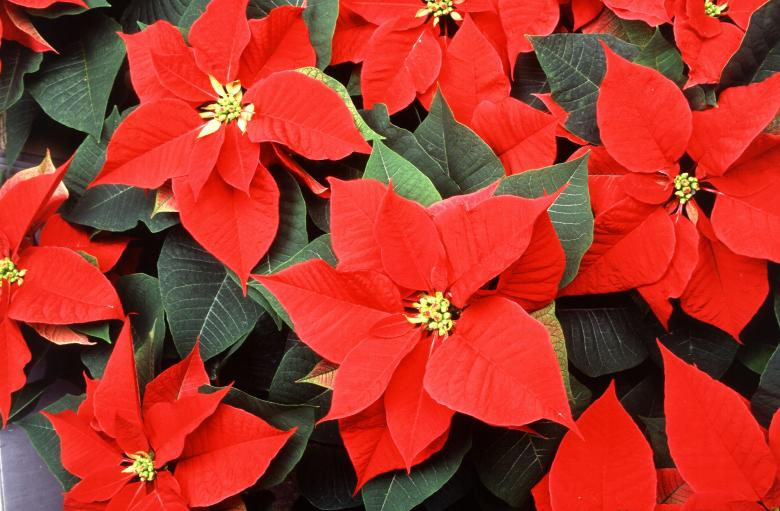
Poinsettias make a great indoor plant with their huge, spectacular, crimson, pointed leaves that emerge from the winter through the early spring. Usually, the colorful leaves on poinsettia houseplants are altered leaves or bright red bracts. The dark green foliage of the plant’s other leaves contrasts with these vividly pigmented crimson leaves.
There are varieties of Euphorbia pulcherrima that have leaves other than the conventional scarlet red hue. Some common houseplants with vibrant colors feature orange, pink, cream, white, or pale green leaves.
5. Madagascar Dragon Tree
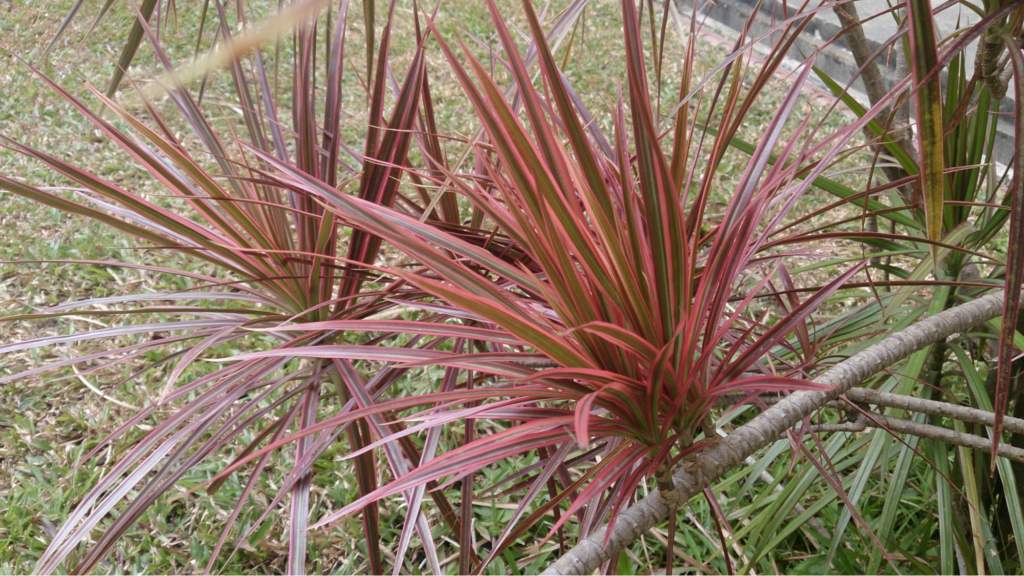
The pointed, ribbon-like leaves of the multicolored Madagascar dragon tree are green, creamy yellow, and pinkish-red. The narrow, tapering leaves have borders that have a light crimson-red and green color.
On top of a tall, thin woody stem, the lovely multicolored leaves form a rosette. The plant’s spiky crown is a result of the thin, tapering, red, and green leaves growing upward.
Madagascar dragon trees may thrive in direct, strong sunshine. The tall indoor houseplant may reach heights of up to 6 ft (1.8 m). This tropical plant that resembles a tree is perfect for giving any interior some colorful height.
6. Cordyline
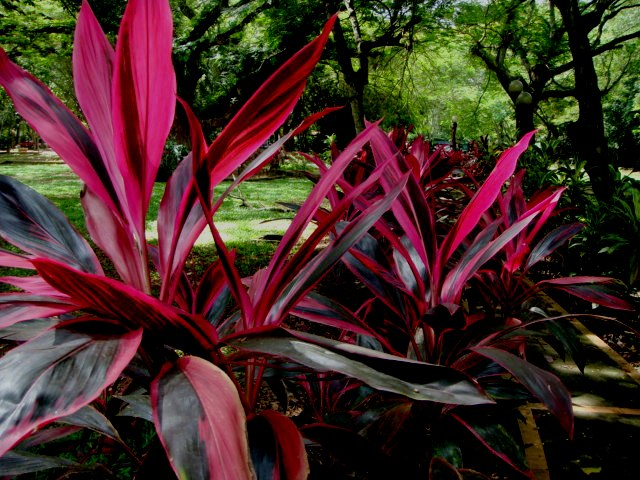
The Ti plant is a common tall indoor evergreen with colorful red and green foliage. The color of the red leaves can vary from bright pink to dark crimson depending on the cultivar and amount of light exposure. The broad, lanceolate leaves develop into a rosette form with striking red crowns and upward-facing, spiky leaves.
The cultivars of Cordyline fruticosa are also known as “Cordyline,” “Cabbage Tree,” and “Hawaiian Good Luck Plant.”
Listed below are a few varieties of Ti plants with vivid red leaves:
- The cordyline plant with wide leaves, known as Cordyline fruticosa ‘Rubra’, has dark green tinges on the rich crimson, scarlet leaves.
- The tall tropical plant Cordyline fruticosa ‘Firebrand’ has dark red and green foliage.
- A tall, beautiful landscape plant with rich pink-red leaves, Cordyline fruticosa ‘Lilinoe’ prefers full light.
7. Red Leaf Begonias
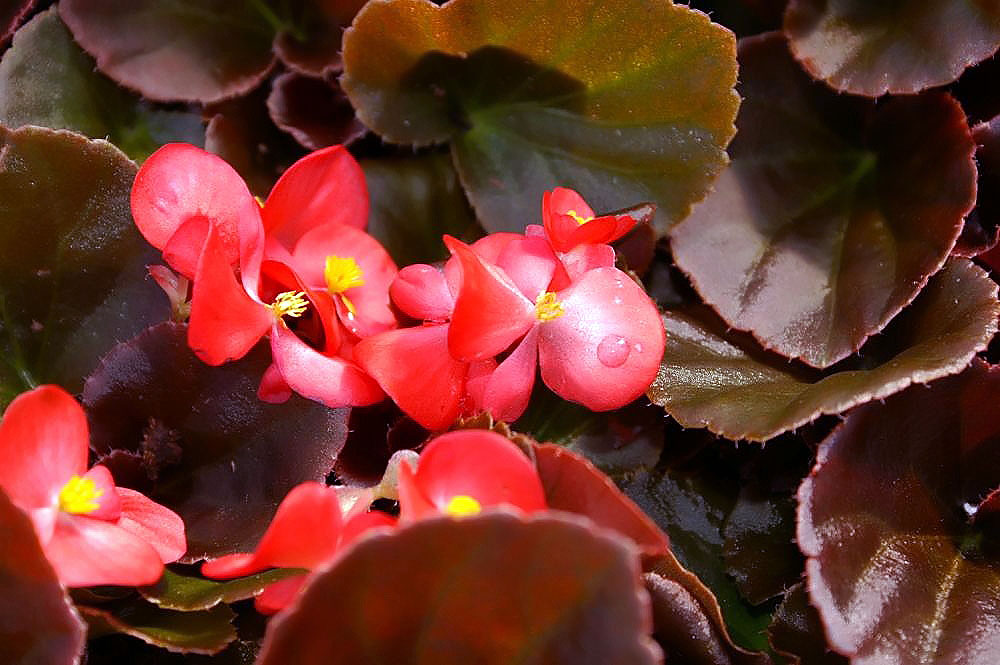
The red leaf of many of the hundreds of begonia species ranges in hue from deep burgundy red to vivid scarlet red. Painted begonias and rex begonias are two of the most beautiful examples of red-leaved begonias. Additionally, wax begonias have delicate pink, white, or red blooms and glossy red foliage.
Here are several begonias with red foliage:
- The medium-sized ‘Omaha Beefsteak’ Begonia (Begonia rex-cultorum) features brilliant reddish-pink leaves with black streaks in the middle.
- Begonia rex’ Crimson Kiss’ has red leaves with purple-black cores. This plant has a striking appearance due to its intense red and purple contrast.
- Begonia’ Red Bull’ is a pointed, small-leaved red begonia with glossy, metallic red leaves with wavy, black leaf edges.
- The trailing begonia hybrid known as “Revelation Maroon” features glossy, rich burgundy leaves with dark green veins. This plant with crimson leaves is perfect for hanging baskets.
- The magnificent Begonia ‘Stained Glass’ features ruby red leaves with bluish-white borders and startling black veins.
8. Crotons
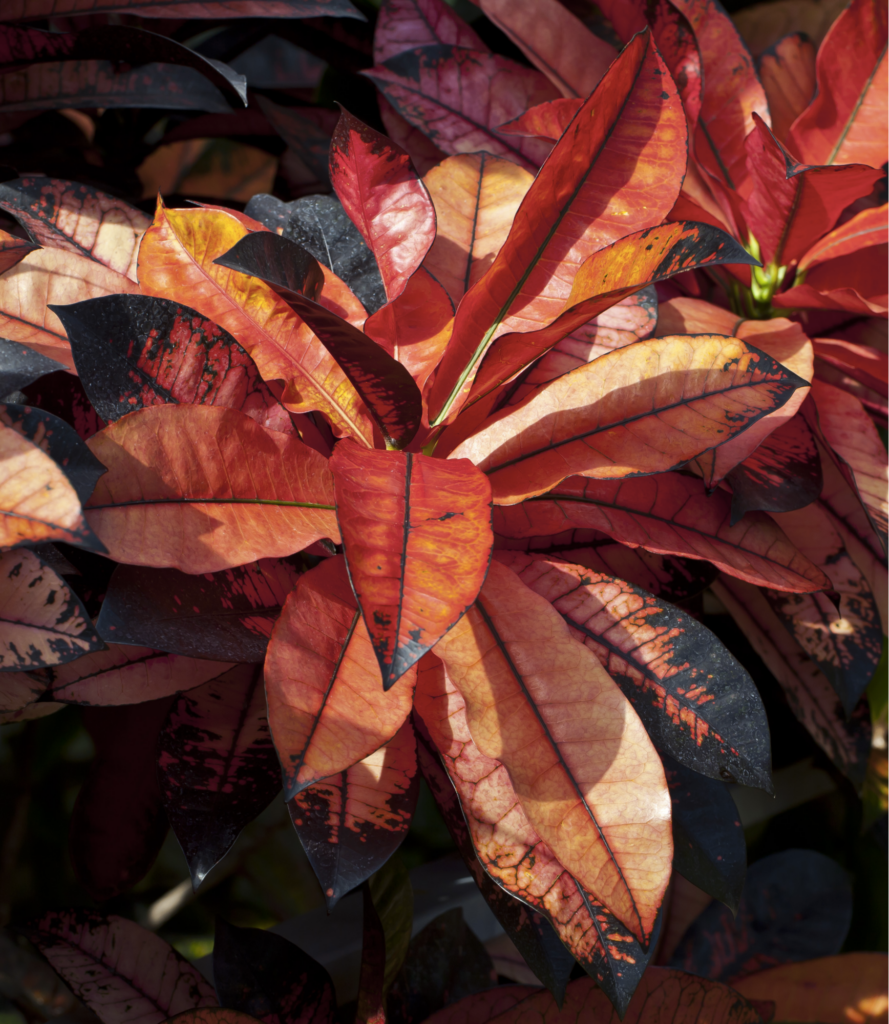
Numerous Croton plant species have vividly colored leaves that are variegated in red, orange, green, and yellow hues.
Croton plants are wonderful houseplants with vibrant foliage that thrive well in warm climates. These indoor plants’ colorful foliage may give tropical hues and brightness to a space.
These croton plant varieties have leaves that are red, green, and yellow:
- The croton plant Codiaeum variegatum’ Mammy Red’ has long, curly leaves with vivid red, orange, green, and yellow patterns. These fiery-looking plants are well-liked indoor plants because of their upright growth.
- The croton houseplant Codiaeum variegatum’ Bush on Fire‘ has colorful, dark lanceolate leaves with dark red, green, and yellowish or orange accents.
- Codiaeum variegatum “Red Secretary” has striking oblong, red and green, wavy-edged leaves.
- Codiaeum variegatum’ Nervia’ has a vivid pinkish-red tint that contrasts with yellow and light green hues.
- The Zanzibar Croton has leaves that are akin to green, red, and orange grass rather than the lanceolate forms of other Crotons. The presence of a water feature is beneficial to these plants. A nearby glass of water or gentle water misting will be beneficial.
The more than 100 species of croton plants all have lance- or oblong-shaped leaves that are variegated. Some croton cultivars feature long, ribbon-like green leaves with red stripes, while others have enormous yellow leaves with green patterns. Other croton cultivars have green leaves with yellow splashes.
9. Polka Dot Plant
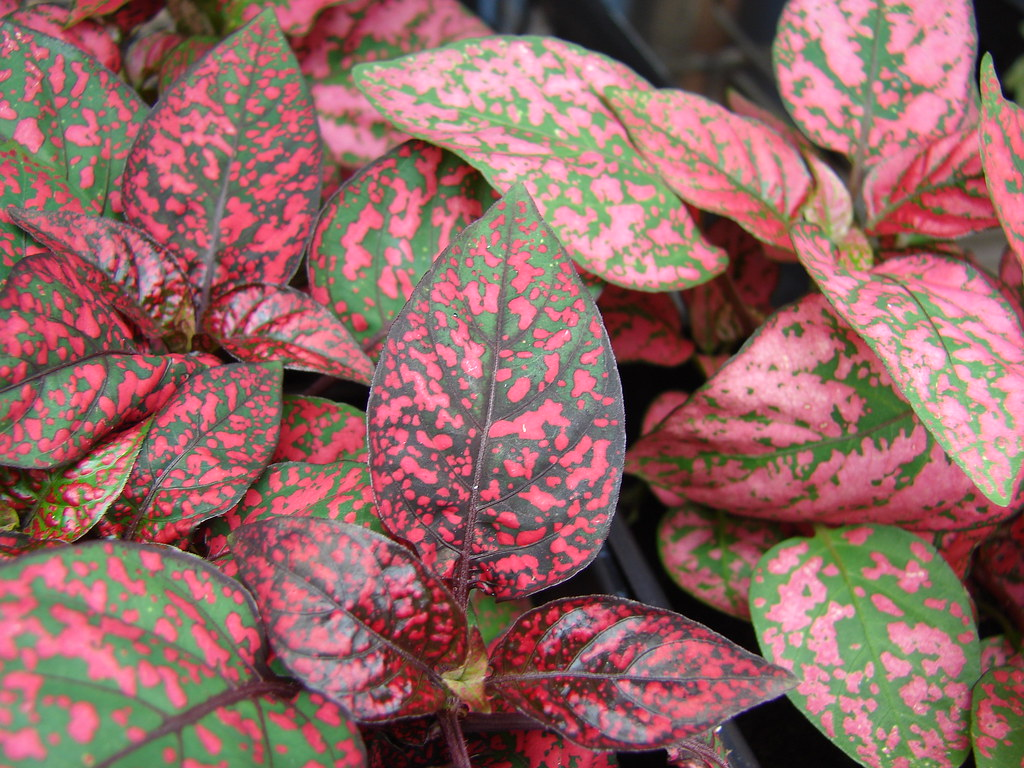
Nerve plants and polka-dot plants are related. Some adorable indoor polka-dot plants have ovate leaves with an egg shape and gorgeous crimson or pink splotches. Some of the tropical leaves appear completely crimson due to the quantity of red on the green foliage.
Polka dot plants are also known as freckle-faced plants and splash plants due to their spotted patterns.
The following cultivars have red leaves with polka dots:
- ‘Crimson Splash Select’ has ovate, red leaves with a central vein covered with tiny green dots.
- Freckle face plant called “Confetti Blush” has delicate green foliage with scarlet or pink dots that resemble freckles.
- Lime green leaves with sporadic crimson or pink splotches, known as “Carmina” polka dots.
10. Anthurium
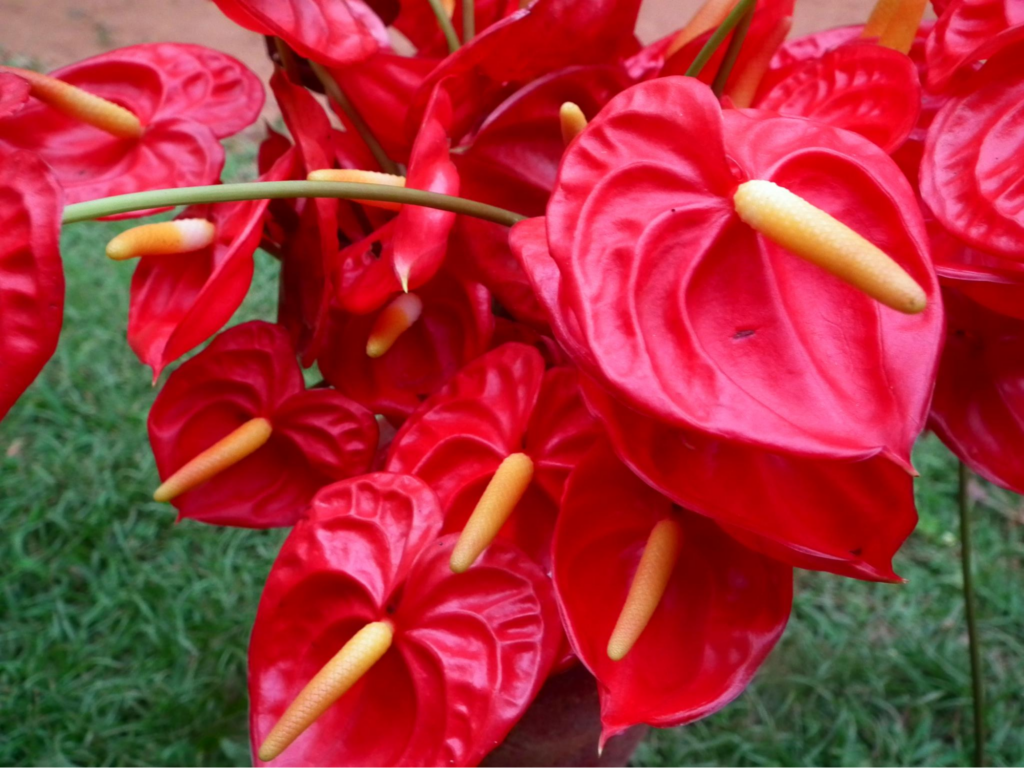
Anthurium plants feature distinctive blossoms that are made up of a yellow or cream-colored flower and a dazzling, brilliant red waxy leaf bract or spathe.
The plant’s green foliage contrasts with the crimson leaf-like bract, which is often heart- or lance-shaped. Beautiful indoor plants called anthurium cultivars feature spathes that are lipstick red, dark orange, light pink, and lilac purple.
Two prominent Anthurium varieties with red leaves are listed below:
- The most popular Anthurium plant is the Flamingo Lily (Anthurium andraeanum), with its waxy, crimson, heart-shaped leaf and yellow-white spadix. The surface of the red spathe is rough and has a lacquered look.
- Anthurium scherzerianum, often known as the Pigtail Lily, is an exotic tropical indoor plant with a waxy leaf (bract) that coils like a pig’s tail and is orange-red in color.
11. Caladium
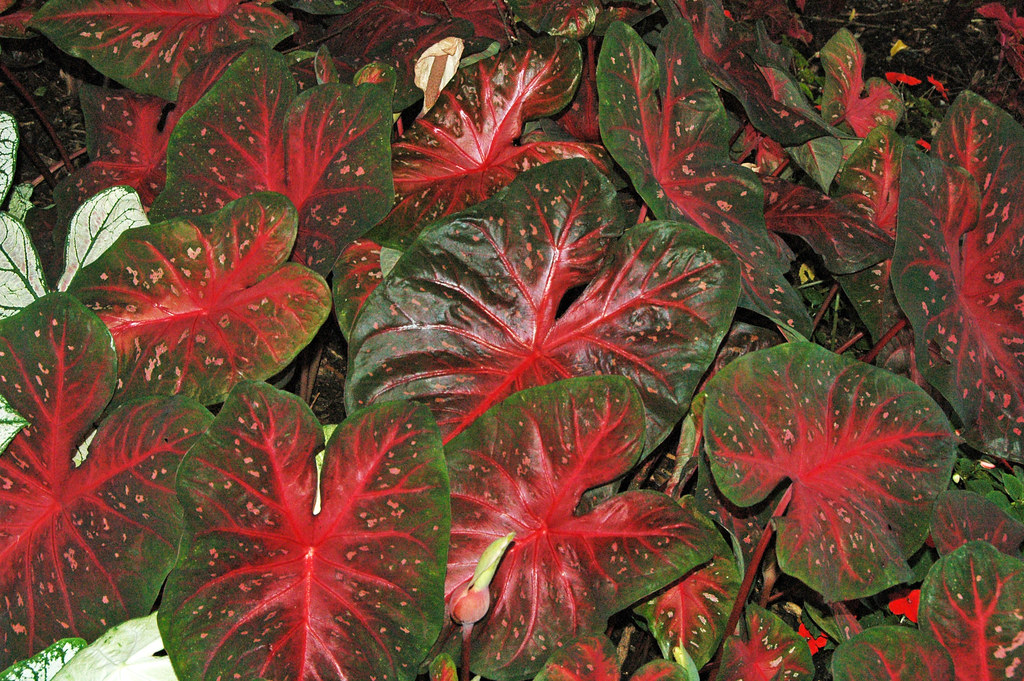
The genus Caladium has tropical foliage plants with red, green, pink, and white bi- and multicolored leaves. Caladium plants, sometimes known as “angel wings” plants, are some of the most gorgeously brilliant leaves of any indoor plant.
The two caladium types are strap-leaved caladiums and fancy-leaved caladiums, both of which have thin, arrowhead-shaped leaves and huge heart-shaped leaves, respectively.
Here are some stunning caladium plant kinds with red and green leaves:
- The fancy-leaf variety of Caladium bicolor known as “Florida Sweetheart” features rosy-red, heart-shaped leaves with wavy green edges. The brilliant pink veining that forms elaborate patterns may be seen in close-up photos of the red leaves.
- The lance-leaf angel wings plant Caladium bicolor “Florida Red Ruffles” features brilliant red or dark pink leaves with ruffled dark green edges. This Caladium cultivar retains its pinkish-red hues even under direct sunlight.
- The fancy-leaved Caladium bicolor variation known as “Red Flash” has green leaves with dark red veins that appear to flow into the green color. The “Red Flash” contains brilliant pink speckles to increase its decorative appeal.
- The Lance-Leaf Caladium has broad, heart-shaped leaves with narrow green borders that have a rich crimson tint. Use a hanging basket or a container filled with peat moss-rich moist soil for drainage. As often as necessary, water the soil to keep it wet.
- Caladium “Bombshell” has vivid red leaves and broad, emerald-green borders, the “Bombshell” caladium is a wonderful houseplant. Any home’s interior is dramatically accented by the vivid red and green colors.
12. Peperomias or Radiator Plants
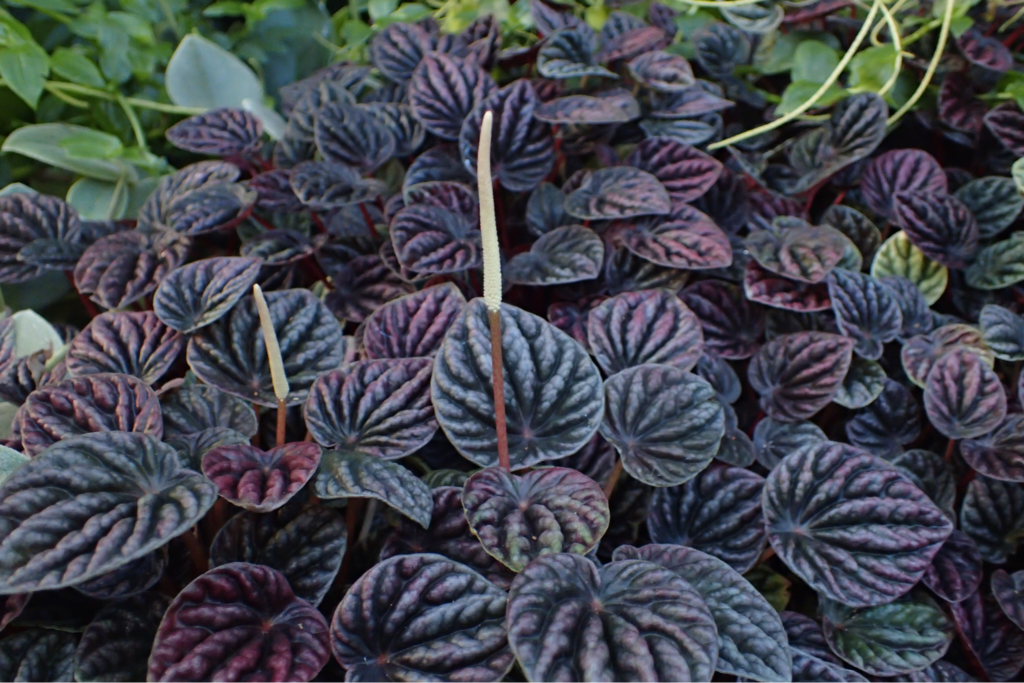
Small tropical houseplants known as radiator plants come in a wide range of leaf color and form variants. It may appear at first glance that attractive peperomia plants have just green foliage. Radiator plants, on the other hand, frequently feature green leaves with crimson undersides and red stems.
Some peperomia plants with red and green foliage are shown here:
- Peperomia caperata, often known as “Emerald Ripple Red,” is a gorgeous dark red pepper plant with heart-shaped leaves that are green and reddish-purple and have a metallic touch.
- Peperomia verticillata, sometimes known as the “Crimson Log” Peperomia, is a gorgeous houseplant with bright red undersides to its leaves. The red and green leaves are similarly fuzzy, as you’ll see.
- Peperomia rubella is a tiny, compact houseplant with green, button-like leaves that have red stems and undersides.
- Peperomia clusiifolia, sometimes known as the “Jelly” radiator plant, is a colorful houseplant with obovate leaves that have stunning hues of green, red, and cream. This plant is also known as “Peperomia Tricolor” because of its vibrant leaves.
13. Succulents
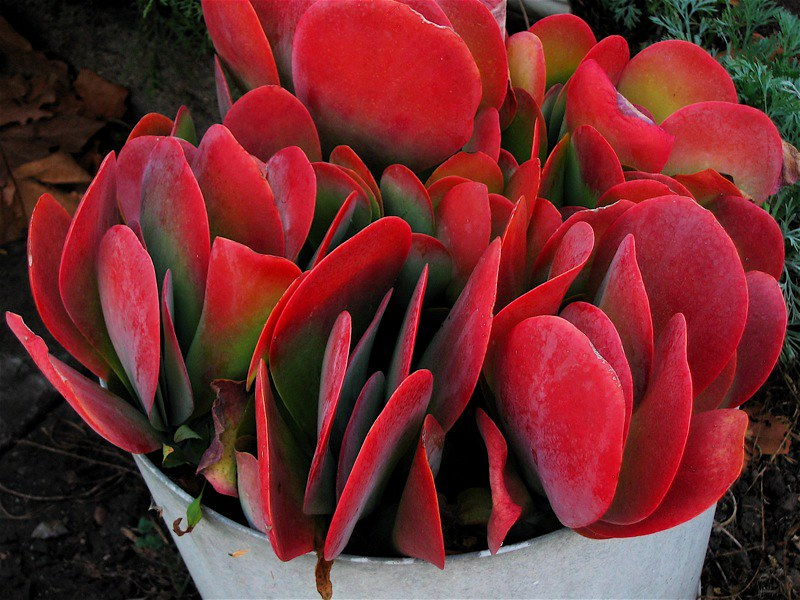
Succulents come in a wide variety with thick, meaty red leaves. Some succulent species have green leaves that flush crimson when exposed to sunshine. Other species of succulents feature leaves that are dark crimson, burgundy, scarlet, or rosy red.
Here are a few examples of lovely succulents with red leaves:
- The magnificent Red Pagoda succulent, Crassula capitella, is a tower of triangular red and green leaves. The triangular leaves resemble a vibrant pagoda as they develop in a rosette pattern. This succulent may also be grown in hanging baskets.
- A little, vivid succulent with narrow leaves that turn from green to orange and scarlet in direct sunshine is called Crassula capitella “Campfire.”
- Sempervivum calcareum has red or orange leaves with a tongue-like appearance. These succulents form a rosette as they develop. While some species have pointed, vivid lipstick red leaves, others have bluish-green leaves with red points.
- Many types of Sedum succulents feature spherical, plump, green, and red fleshy leaves. One such variety is Sedum rubrotinctum ‘Aurora‘. Sedum succulents that receive a lot of sunshine have leaves that are vivid red and scarlet. Sedums have bicolored leaves that are red and green under lesser light.
Gymnocalycium mihanovichii, also known as the moon cactus, is gorgeous grafted cactus with a vibrant ball-shaped top that is typically red, yellow, pink, or orange in hue.
RELATED: 25 Beautiful And Easy To Grow Purple Succulents For Homes & Offices
14. Tradescantia
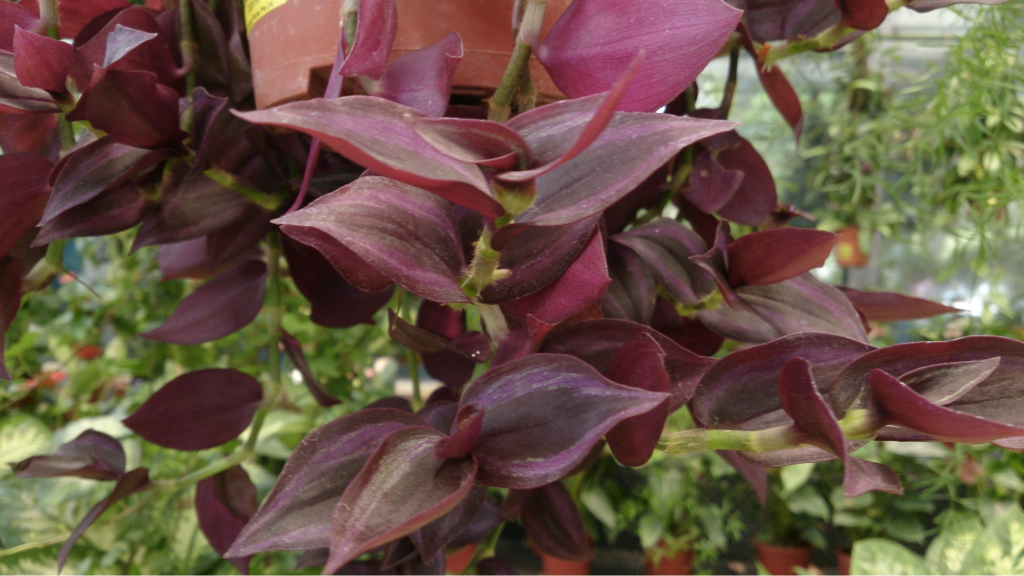
A genus of perennial plants called Tradescantia has vivid lanceolate or ovate-oblong leaves. There are 75 different species of Tradescantia, most of which are typical houseplants with reddish-purple leaves—some with stripes, some without.
Many members of the Tradescantia genus make excellent hanging basket plants due to their long, trailing stems and gorgeous green leaves.
Other names for Tradescantia plants include “wandering jew,” “spiderwort,” “spider-lily,” “oyster plants,” and “flowering inch plant.”
Some Tradescantia plants with reddish foliage are listed below:
- Tradescantia’ Cool Leaf’ have woody stems topped with dark pinkish-red leaves.
- Tradescantia spathacea, often known as Boat Lily or Moses-in-the-Cradle, has reddish-purple pointed leaves.
- The reddish-green leaves of this “inch plant,” known as the Wandering Jew ‘Red’, feature stripes on the top side and are burgundy red on the underside.
- The inch plant “Quadricolor” (Tradescantia zebrina “Quadricolor”) has lance-shaped leaves with green and dark purplish-red stripes on the top sides and dark maroon on the undersides. It is a four-colored silver inch plant.
15. Bromeliads
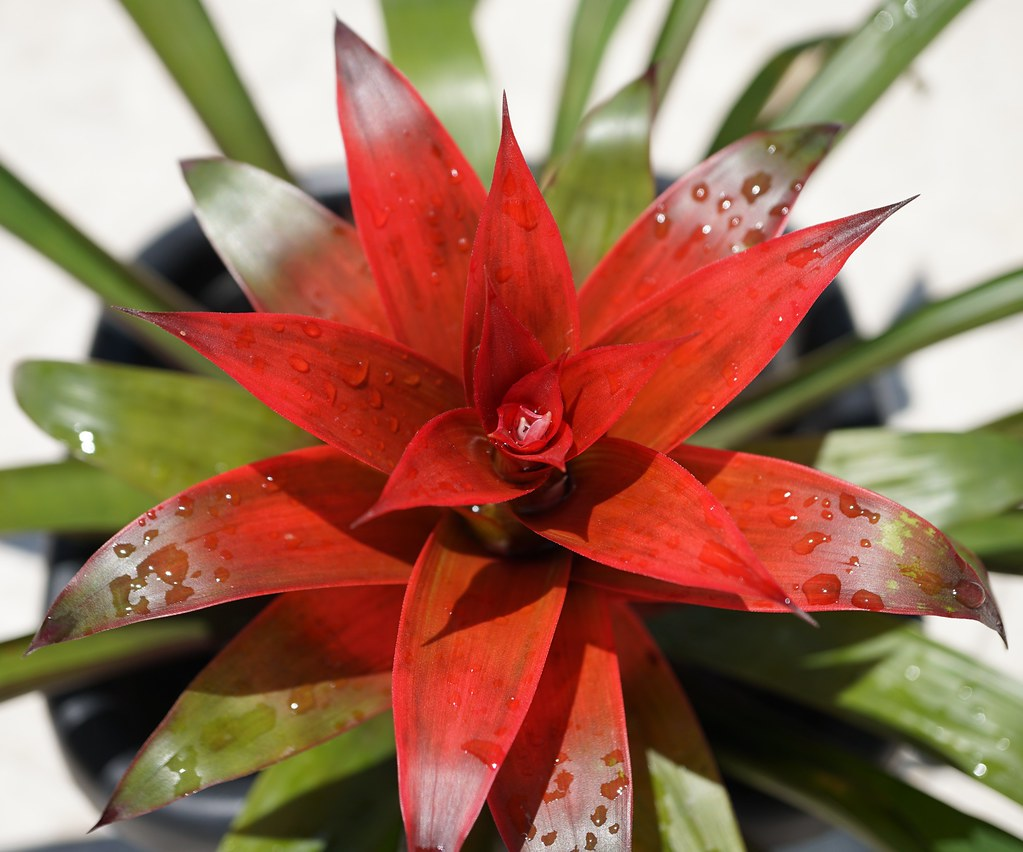
A family of plants known as bromeliads has large, leathery leaves that can be white, red, yellow, or variegated in color. Many bromeliad species resemble enormous, vivid rosette-shaped flowers.
These “flowers,” however, are actually bracts, which are colorfully altered leaves. The rosette leaves can have a variety of hues, including fiery red, fall orange, dazzling yellow, or mixtures of red and yellow.
The majority of bromeliad species can thrive in humid environments with little light. They are the perfect tropical plants for bathrooms because of this..
16. Burgundy Ficus
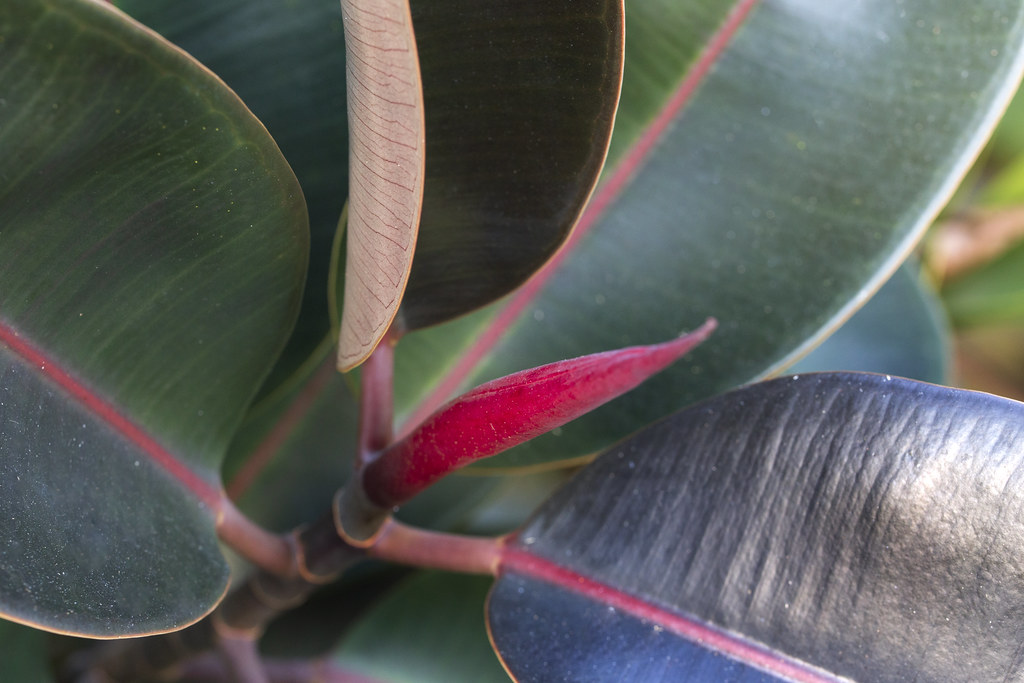
As a houseplant, the Burgundy Ficus requires need minimal maintenance. Really, all it needs to grow is a sufficient quantity of direct and bright indirect light as well as some water.
Its leaves are thick, glossy, and dark green with crimson veins. As the plant develops and ages, they undergo a color shift.
17. Callisia repens
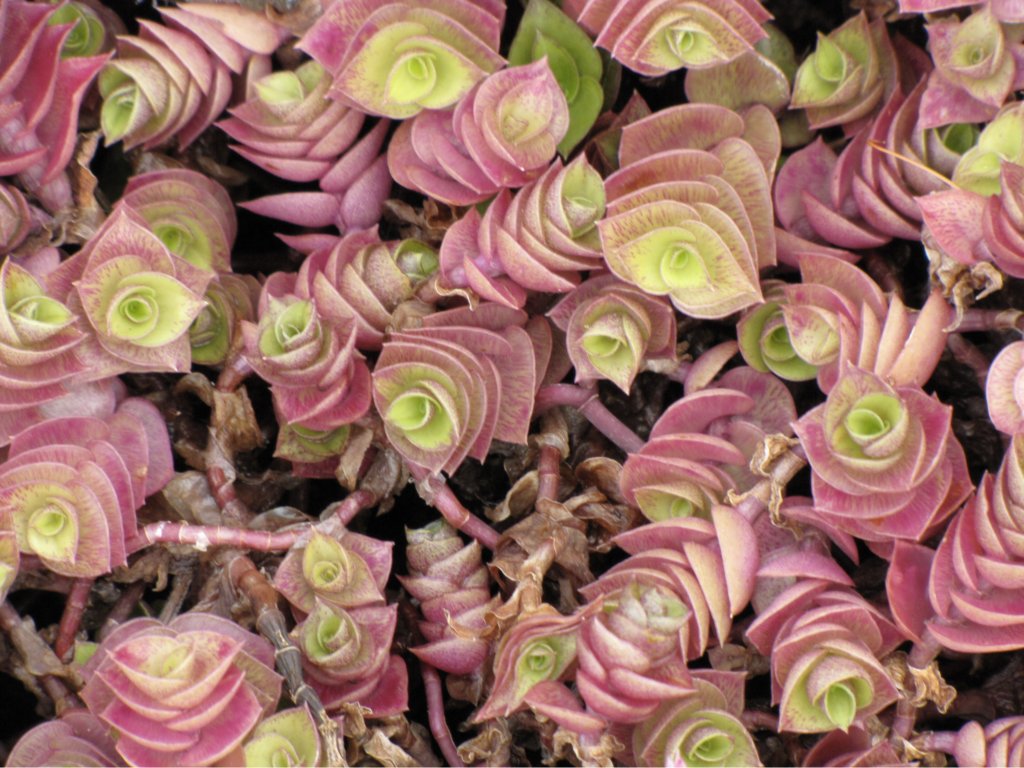
The tiny, oval leaves of this plant range in color from green to pink to red. The trailing growth pattern looks fantastic on ledges.
Mist the plant to mimic dampness. Make use of quick-draining soil, such as peat. Whether in a hanging basket or a container, let the soil surface to dry out between waterings.
18. Philodendrons
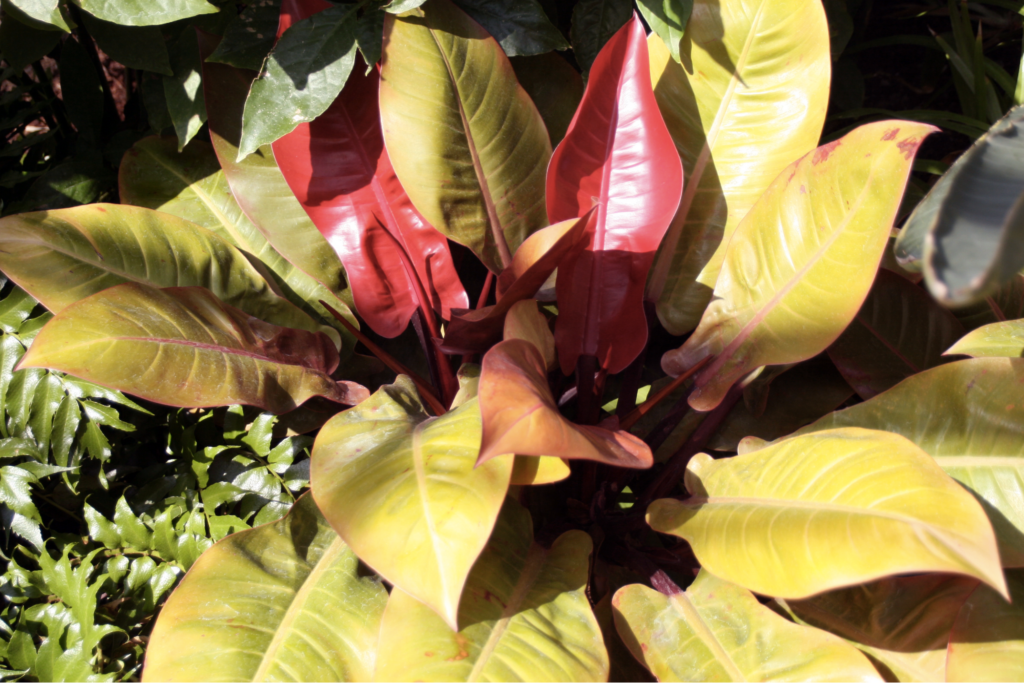
This list won’t be complete without Philodendrons. Philodendrons are among the most diverse and well-loved houseplants there are. They are available in a wide array of colors, including shades of red.
Here are some of the red-leaf Philodendrons you can put in your home:
- The Black Cardinal Philodendron has beautiful crimson leaves that get darker as they age. The leaves differ from other philodendrons’ usual heart-shaped leaves in another way. In contrast to other varieties of philodendron, they also self-head.
- If you are familiar with philodendrons, you might think of them as having a propensity of climbing or vining rather than the Red Congo Philodendron. With long, wide, evergreen leaves that unfold, this plant grows much like other plants. The leaves initially have a calming, bright crimson hue that gradually fades with age.
- One of the more popular small tropical evergreens is the Imperial Red Philodendron. They like to grow laterally rather than a vine, unlike other philodendrons. These, too, have compact rosettes of leaves that self-head.
The Imperial Red and Red Congo are fairly similar, yet there are several key differences. Imperial Reds have crimson leaves that, as they mature, become dark burgundy, then dark green. They have the capacity to produce reddish-purple blooms in the wild.
When you can give warm temperatures, brilliant shade, constant hydration, and a lot of humidity, growing an Imperial Red Philodendron is simple. These circumstances resemble its tropical natural environment.
RELATED: 9 Stunning Rare Philodendrons; With Tips To Help Them Thrive
19. Japanese Red Maple Bonsai
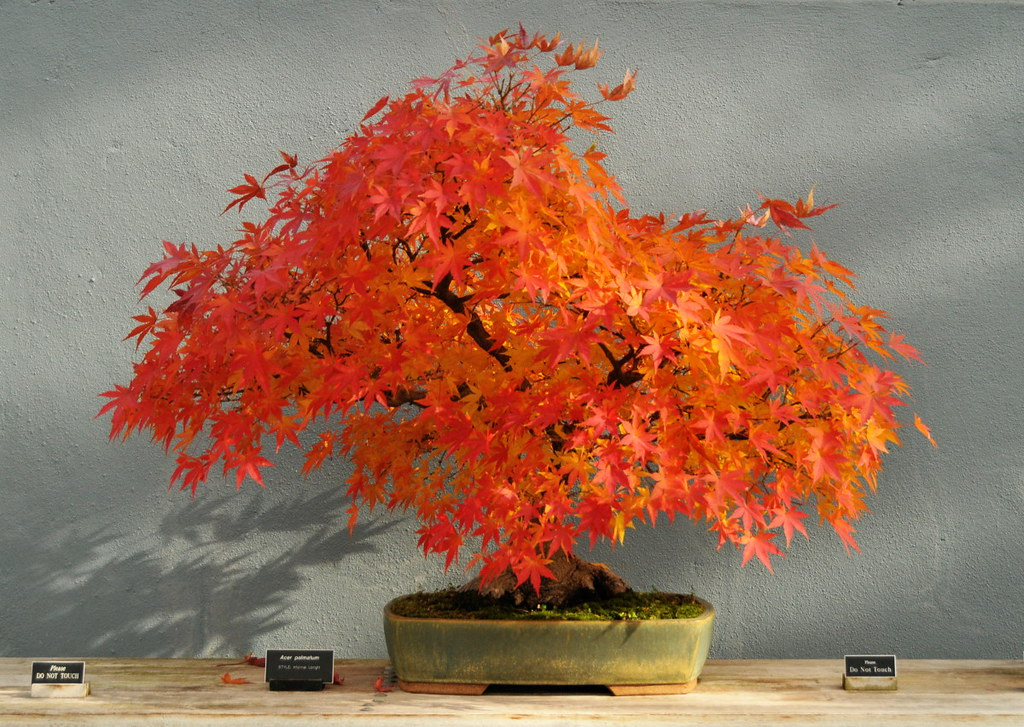
Without a doubt, one thing that inspires us to go deeper into the world of bonsai is the stunning red of the maples! Acer palmatum, sometimes referred to as the Japanese Maple, is a plant that is indigenous to Korea, China, and Japan.
The plant’s scientific name comes from its hand-shaped, five-lobed leaves. The family of maples is one of the most well-liked bonsai species, along with pines and junipers.
Similar to oaks, maples are deciduous trees that spread widely and aren’t very large. In order to prevent leaf burn in the summer, maples must be protected from direct sunlight and crushed while the temperature is between 20 and 5 degrees Celsius. In colder climates, maple trees also need to be protected.
20. Red Pencil Plant
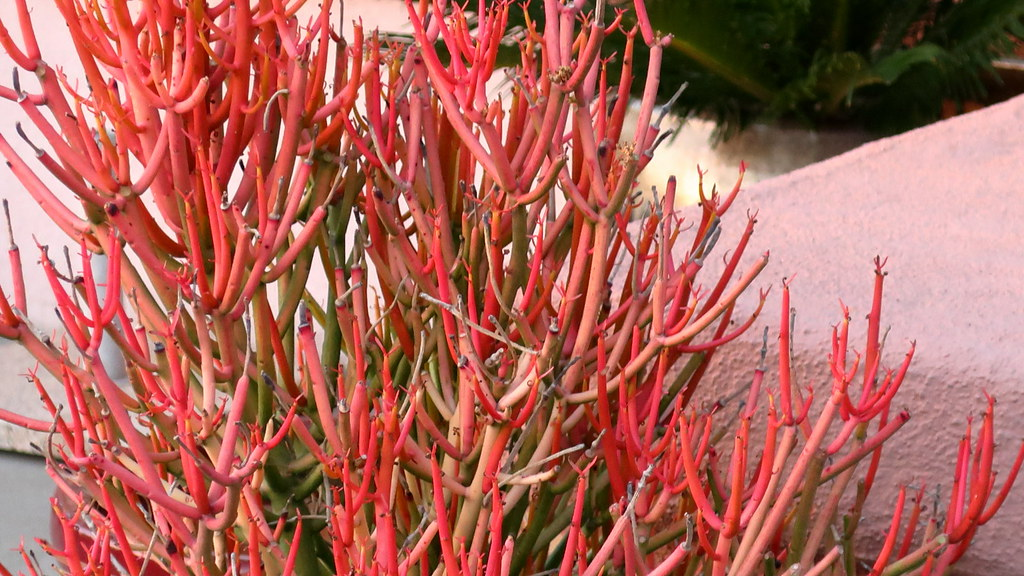
The pencil cactus, Euphorbia tirucalli, sometimes known as ET, is not a cactus. Instead, it’s a hardy succulent that may grow as tall as 40 feet in the wild. Also known as Sticks on Fire, this plant develops much more slowly and is probably never going to be the same size as the parent plant since it lacks chlorophyll.
You may restrict the plant to a more manageable height of 6 to 8 feet when grown as a houseplant. The countless branches of this amazing tree contain small, unnoticeable leaves that are as thin as pencils, have a reddish-golden hue, and dissipate swiftly.
This plant prefers temperatures between 50 and 70 degrees Fahrenheit even though it can endure temperatures as high as 100 degrees. Similar to how the color changes with the seasons, turning redder in the winter and fading to a golden color in the summer, it is best grown in full sunshine.
21. Copper Leaf Plant
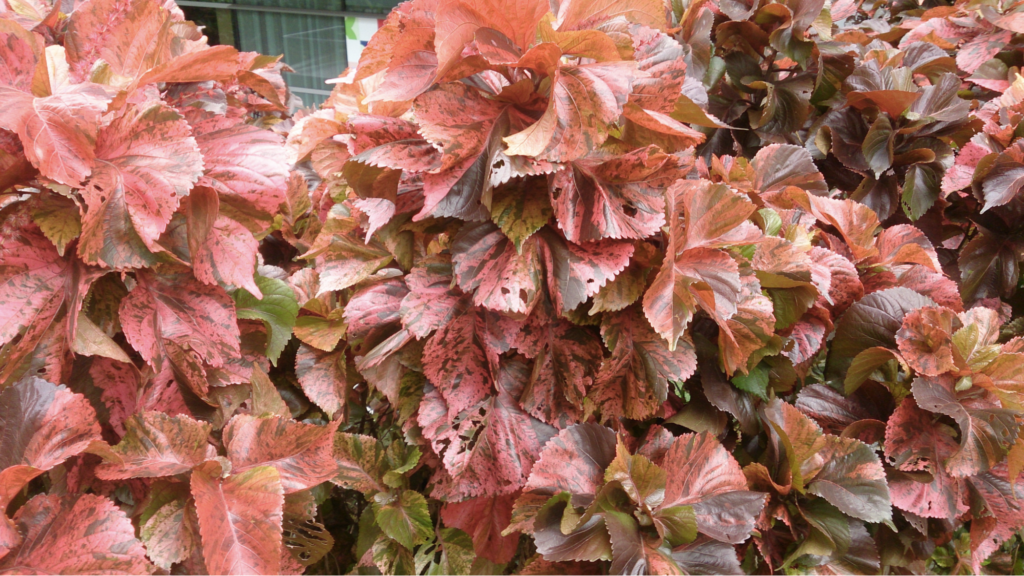
The Copper Leaf Plant is a subtropical evergreen plant also known as Acalypha wilkesiana. This colorful Acalypha plant is native to Vanuatu and several of the Pacific Islands. It belongs to the Acalyphinae subtribe of the Euphorbiaceae family.
Each variant of the leaves’ streaked, splashed, and bordered colors is more exquisite than the previous, and they come in shades of pink, crimson, golden, purple, and green. ‘Mooreana’ has leaves with deeply red veining and serrated edges. Golden leaves with red margins are found on “Marginata.”
Whether it is placed indoors or outside, the growing medium’s temperature has to be above 55 degrees Fahrenheit (13 degrees Celsius). Additionally, in USDA Hardiness Zones 9 to 12, the perennial plant spreads throughout the summer.
22. Iresine Bloodleaf Plant
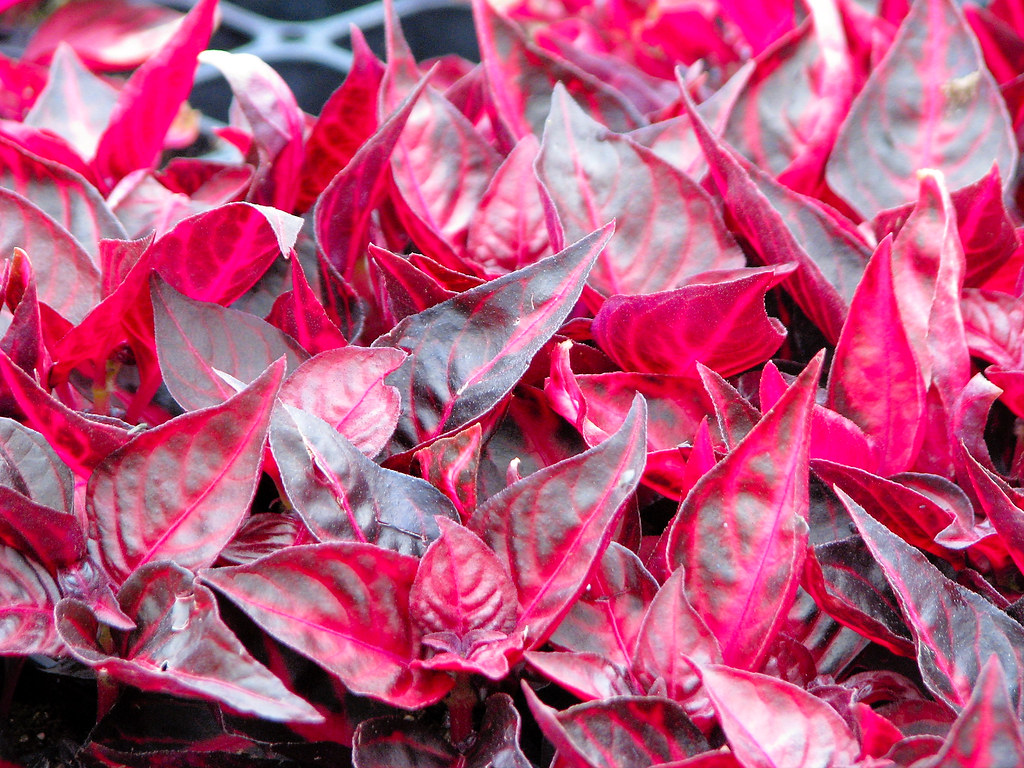
Brazil is home to the unique Iresine bloodleaf plant, which thrives in hot conditions and intense sunlight.
In their native environment, the plants may reach heights of up to 5 feet (1.5 m) with a spread of 3 feet (91 cm). However, when planted as annuals or potted plants, they barely reach heights of 12 to 18 inches (31-46 cm).
Additionally, beds and borders are contrasted by the variegated red leaves with green and white patterns. Bloodleaf plants may be cultivated outside year-round in USDA plant hardiness zones 10 and 11, where they flourish in extreme heat and humidity.
Final Thoughts
The red plants list might be overwhelming, but surely, there is a red-leaf plant that is ideal for you, regardless of whether your house is light and airy, dark and shady, chilly, warm, hot, dry, or humid. If your ceilings are high, you may have a tall plant, or you can have a little plant to brighten a window.
So, if you’re short on time, you have all these possibilities as well as the choice of something minimal maintenance in your indoor plant collection. Most plants also purify the air we breathe, so enhance the beauty of your environment by including some red today!
Editor’s Recommendations
Will Houseplants Grow Under Normal LED Lights? Or Do I Need Something Special!
It’s Getting Hot In Here!: Increasing Humidity For Your Houseplants







